#cudjoe
Explore tagged Tumblr posts
Text
Cudjoe and Nanny Smith straddle the 17th and 18th Centuries and the shift from Spanish power to British:
Another in the sequence of great charismatic resistance leaders would be Cudjoe, who had an even longer career than Sebastian Lemba. His started in the 1690s and laid the groundwork for the unified communities that would fight the First Maroon War in the 1730s. Cudjoe and Nanny, his sister and governor of the first independent Black community in the now-British Empire, Nanny Town, put up a long fight though she died before he did by murder at the hands of the British Empire. The Empire grudgingly signed the treaties with the Maroons who had semi-official recognition and cast a long shadow over the sugar empire that took its specifically British form over the Spanish.
#lightdancer comments on history#black history month#military history#black resistance#history of slavery#jamaican maroons#cudjoe
5 notes
·
View notes
Text
Cudjoe joins Fi Wi Nyam Yam Jam Fest

Cudjoe joins Fi Wi Nyam Yam Jam Fest. Read Eugene Pitter's article about businessman Cudjoe who joins the forthcoming yam fest in Jamaica. #Cudjoe #FiWiNyamYamJamFest #EugenePitter Read the full article
0 notes
Text


Bilal Cudjoe by Jonathan Frantini for GQ France Magazine May 2019
64 notes
·
View notes
Text

Bilal Cudjoe for Philipp Plein, Pre-Fall 2023
2 notes
·
View notes
Text

Artist rendition of Cudjoe left, sketch of Cudjoe on right.
Articles of Pacification with the Maroons of Trelawney Town, Concluded March the first, 1738
In the name of God, Amen, Whereas Captain Cudjoe, Captain, Acompong, Captain Johnny, Captain Cuffee, Captain Quaco, and several other Negroes, their dependents and adherents, have been in a state of ware and hostility, for several years past, against our sovereign lord the King, and the inhabitants of this island; and whereas peace and friendship among mankind, and the preventing of effusion of blood, is agreeable to God, consonant to reason, and desired by every good man; and whereas his Majesty George the Second, King of Great Britain, France, and Ireland, and of Jamaica Lord, Defender of the Faith, &c. has by his letters patent, dated February the twenty-fourth, one thousand seven hundred and thirty-eight, in the twelfth year of his reign, granted full power and authority to John Guthrie and Francis Sadler, Esquires, to negotiate and finally conclude a treaty of peace and friendship with the aforesaid Captain Cudjoe, and the rest of his captains, adherents, and others his men; they mutually, sincerely, and amicably, have agreed to the following articles:
Articles of Pacification with the Maroons of Trelawney Town, Concluded March the first, 1738
In the name of God, Amen, Whereas Captain Cudjoe, Captain, Acompong, Captain Johnny, Captain Cuffee, Captain Quaco, and several other Negroes, their dependents and adherents, have been in a state of ware and hostility, for several years past, against our sovereign lord the King, and the inhabitants of this island; and whereas peace and friendship among mankind, and the preventing of effusion of blood, is agreeable to God, consonant to reason, and desired by every good man; and whereas his Majesty George the Second, King of Great Britain, France, and Ireland, and of Jamaica Lord, Defender of the Faith,. has by his letters patent, dated February the twenty-fourth, one thousand seven hundred and thirty-eight, in the twelfth year of his reign, granted full power and authority to John Guthrie and Francis Sadler, Esquires, to negotiate and finally conclude a treaty of peace and friendship with the aforesaid Captain Cudjoe, and the rest of his captains, adherents, and others his men; they mutually, sincerely, and amicably, have agreed to the following articles:
First, That all hostilities shall cease on both sides for ever.
Secondly, That the said Captain Cudjoe, the rest of his captains, adherents, and men shall for ever hereafter in a perfect state of freedom and liberty, excepting those who have been taken by them, or fled to them, within two years last past, if such are willing to return to their said masters and owners, with full pardon and indemnity from their said masters or owners for what is past; provided always that, if they are not willing to return, they shall remain in subjection to Captain Cudjoe and in friendship with us, according to the form an tenor of this treaty.
Thirdly, That they shall enjoy and posses, for themselves and posterity for ever, all the lands situate and lying between Trelawney Town and the Cockpits, to the amount of fifteen hundred acres, bearing northwest from the said Trelawney Town.
Fourthly, That they shall have liberty to plant the said lands with coffee, cocoa, ginger, tobacco, and cotton, and to breed cattle, hogs, goats, or any other flock, and dispose of the produce or increase of the said commodities to the inhabitants of this island; provided always, that when they bring the said commodities to market, they shall apply fist to the customs, or any other magistrate of the respective parishes where they expose their goods to sale, for a license to vend the same.
Fifthly, That Captain Cudjoe, and all the Captain’s adherents, and people now in subjection to him, shall all live together within the bounds of Trelawney Town, and that they have liberty to hunt where they shall think fit, except within three miles of any settlement, crawl, or pen; provided always, that in case the hunters of Captain Cudjoe and those of other settlements meet, then the hogs to be equally divided between both parties.
Sixthly, That the said Captain Cudjoe, and his successors, do use their best endeavors to take, kill, suppress, or destroy, either by themselves, or jointly with any other number of men, commanded on that service by his excellency the Governor, or Commander in Chief for the time being, all rebels wheresoever they be, throughout this island, unless they submit to the same terms of accommodation granted to Captain Cudjoe, and his successors.
Seventhly, That in case this island be invaded by any foreign enemy, the said Captain Cudjoe, and his successors hereinafter named or to be appointed, shall then, upon notice given, immediately repair to any place the Governor for the time being shall appoint, in order to repel the said invaders with his or their utmost force, and to submit to the orders of the Commander in Chief on that occasion.
Eighthly, That if any white man shall do any manner of injury to Captain Cudjoe, his successor, or any of his or their people, they shall apply to any commanding officer or magistrate in the neighbourhood for justice; and in case Captain Cudjoe, or any of his people, shall do any injury to any whiter person, he shall submit himself, or deliver up such offenders to justice.
Ninthly, That if any negroes shall hereafter run away from their masters or owners, and shall fall into Captain Cudjoe’s hands, they shall immediately be sent back to the chief magistrate of the next parish where they are taken; and these that bring them are to be satisfied for their trouble, as the legislature shall appoint. [The assembly granted a premium of thirty shillings for each fugitive slave returned to his owner by the Maroons, besides expenses.]
Tenthly, That all negroes taken, since the raising of this party by Captain Cudjoe’s people, shall immediately be returned.
Eleventhly, That Captain Cudjoe, and his successors, shall wait on his Excellency, or the Commander in Chief for the time being, every year, if thereunto required.
Twelfth, That Captain Cudjoe, during his life, and the captains succeeding him, shall have full power to inflict any punishment they think proper for crimes committed by their men among themselves, death only excepted; in which case, if the Captain thinks they deserve death, he shall be obliged to bring them before any justice of the peace, who shall order proceedings on their trial equal to those of other free negroes.
Thirteenth, That Captain Cudjoe with his people, (Repeat: subjects, peoples.) shall cut, clear, and keep open, large and convenient roads from Trelawney Town to Westmorland and St. James’s, and if possible to St. Elizabeth’s.
Fourteenth, That two white men, to be nominated by his Excellency, or the Commander and Chief for the time being, shall constantly live and reside with Captain Cudjoe and his successors, in order to maintain a friendly correspondence (Not dominance, correspondence — see “waiting”. These are ambassadors, not governors) with the inhabitants of this island.
Fifteenth, That Captain Cudjoe shall, during his life, be Chief Commander in Trelawney Town; after his decease the command to devolve on his brother, Captain Accompong; and in case of his decease, on his next brother Captain Johnny; and, failing him, Captain Cuffee shall succeed; who is to be succeeded by Captain Quaco; and after all their demises, the Governor, or Commander in Chief for the time being, shall appoint, from time to time, whom he thinks fit for that command.
#Articles of Pacification with the Maroons of Trelawney Town#Concluded March the first#1738#Jamaica#Maroons of Jamaica#Maroon Treaty in Jamaica#Trelawny#Accompong#Captain Cudjo
5 notes
·
View notes
Text

"It's crazy to think they would have sailed right past here," Darron Patterson said, pulling his car onto a scrap of grass overlooking the murky Mobile River. As president of the Clotilda Descendants Association, Patterson is well versed in talking about the voyage of the Clotilda – the last known slave ship to reach America. His great-great-grandfather was Kupollee, later renamed Pollee Allen; one of the 110 men, women and children cruelly stolen from Benin in West Africa and brought to the US onboard the notorious ship.
The story of how Patterson's relative arrived in America aboard an illegal slaver started as a shockingly flippant bet. Fifty-two years after the US banned the importation of enslaved people, in 1860, a wealthy Alabama business owner named Timothy Meaher wagered that he could orchestrate for a haul of kidnapped Africans to sail under the noses of federal officers and evade capture.
With the assistance of Captain William Foster at the helm of an 80ft, two-mast schooner, and following a gruelling six-week transatlantic passage, he succeeded. The ship sneaked into Mobile Bay on 9 July under a veil of darkness. To conceal evidence of the crime, the distinctive-looking schooner – made from white oak frames and southern yellow pine planking – was set ablaze and scuttled to the depths of the swampy Mobile River, where it lay concealed beneath the water, its existence relegated to lore.
That is until almost 160 years later, when during a freakishly low tide, a local reporter named Ben Raines discovered a hefty chunk of shipwreck in the Mobile River, initially thought to belong to the Clotilda. It turned out to be a false alarm, but the discovery reignited interest and led to an extensive search involving multiple parties, including the Alabama Historical Commission, National Geographic Society, Search Inc and the Slave Wrecks Project. Following their exhaustive effort, in May 2019 it was finally announced that the elusive Clotilda had at long last been discovered.
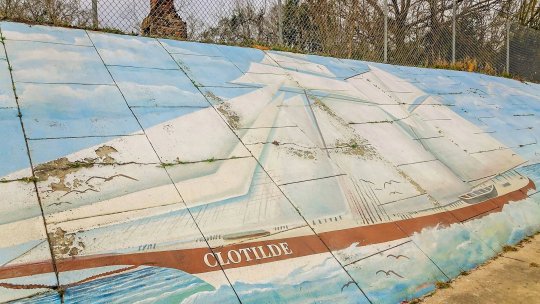
A mural of the Clotilda slave ship runs alongside the freeway separating the two sides of Africatown (Credit: Carmen K Sisson/Alamy)
Three years later, the city of Mobile found itself standing on the brink of a tourism boom, as interest in the story of the Clotilda, and the lives of its resilient captives, built.
Patterson had agreed to drive me around Africatown, an area where many of the ship's captives finally settled and where Patterson himself was raised. We began the tour at this scrap of land by the Mobile River, beneath a soaring interstate bridge where a group of Clotilda slave ship descendants meet annually for their Under the Bridge festival, to "talk about how our ancestors got here and to have some food and dance," Patterson said. There was no festival that day though and the atmosphere was muted; just one woman and her grandson played by the marshy water's edge below the steady hum of traffic.
Walking back to his car, Patterson, a former sportswriter now in his 60s, recalled that growing up, Africatown was a thriving, self-sufficient place, where "the only time we needed to leave the community was to pay a utility bill" as everything needed was close to hand, aside from a post office.
Located three miles north of downtown Mobile, Africatown was founded by 32 of the original Clotilda survivors following emancipation at the end of the Civil War, in 1865. Longing for the homeland they'd been brutally ripped from, the residents set up their own close-knit community to blend their African traditions with American folkways, raising cattle and farming the land. One of the first towns established and controlled by African Americans in the US, Africatown had its own churches, barbershops, stores (one of which was owned by Patterson's uncle); and the Mobile County Training School, a public school that became the backbone of the community.
However, this once-vibrant neighbourhood fell on hard times when a freeway was constructed in the heart of it in 1991, and industrial pollution meant that many of the remaining residents eventually packed up and left. "We couldn't even hang out our washing to dry because it would get covered in ash [a product of the oil storage tanks and factories on the outskirts of Africatown]," said Patterson. With the high-profile closure of the corrugated box factory, International Paper, in 2000, and an ensuing public health lawsuit brought about by residents, Africatown's community that had swelled to 12,000 people in the 1960s plummeted to around 2,000, where it stands today.
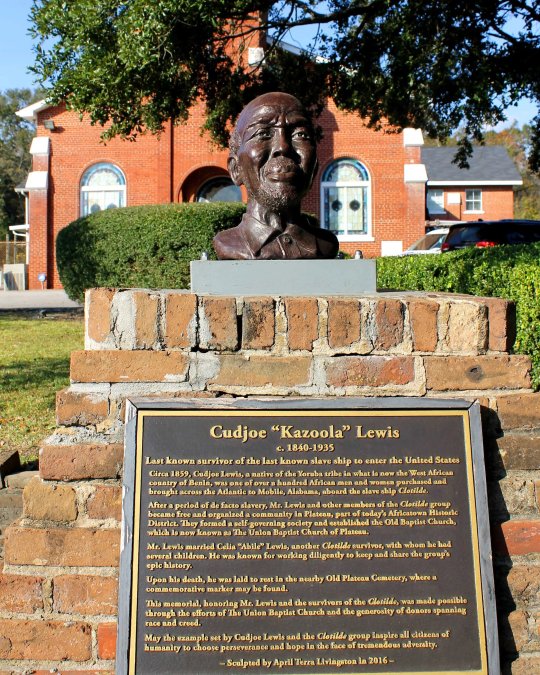
Cudjoe Kazoola Lewis, one of the Clotilda survivors and founders of Africatown, died in 1935 (Credit: Zoey Goto)
The exodus, poverty and environmental scars were visible as Patterson drove further into Africatown. The roadside was littered with abandoned factories. The quiet, residential streets were peppered with empty lots and vacant homes, some in such disrepair that their decaying walls had surrendered entirely to the creeping vines engulfing them.
But Africatown is changing, once again. With the discovery of the ship's remnants came the interest necessary to rebuild and preserve this historical place; an influx of attention and funds that is affecting everything from personal relationships to history to the fortune of the neighbourhood. Because, though the story of the Clotilda was known – and the lives of the original passengers were so well documented that photos, interviews and even film footage existed – without evidence of the vessel, the history was buried and it was not in the interest of the white population to acknowledge the truth of how they had arrived. Finding the vessel allowed their story to be affirmed and truth to be restored after decades of denial.
In the years since the Clotilda was discovered, the wreck has undergone extensive archaeological exploration to determine the likelihood of raising it safely. The ripple effect of media and public interest has meant a slew of government, community and private funding for Africatown's revitalisation, including The Africatown Redevelopment Corporation, which is using grants to restore homes in disrepair and demolishing and rebuilding derelict lots. Added to this is a $3.6 million payout from a BP oil spill settlement that has been earmarked for the long-awaited rebuilding of the Africatown Welcome Center, which was swept away in 2005 by Hurricane Katrina.
Patterson drove me to his grandmother's house and pulled over to chat with an elderly neighbour on her porch ("no photos, mind", she requested politely). Unlike some of the other descendent families, he told me, growing up he was told little of his ancestry. "I think my folks may have been embarrassed," he reflected, recalling that the smuggled captives had faced many humiliations, including being stripped naked for the voyage. "That must have just broke their will," Patterson said.
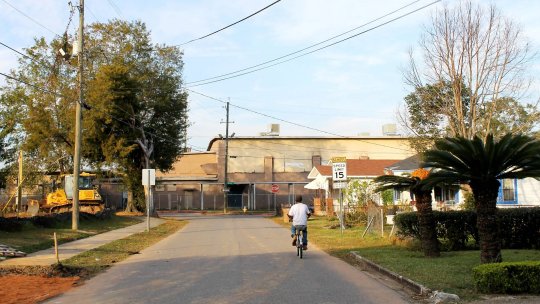
Africatown was one of the first towns established and controlled by African Americans in the US (Credit: Zoey Goto)
The 2019 announcement of the ship's discovery galvanised Patterson's curiosity, and he started to piece together his heritage, at which point his "whole life changed". He's since become hands-on in ensuring the story is told accurately, including an onscreen role in the film Descendant premiering at the 2022 Sundance Film Festival and as co-producer of the second installment of the forthcoming documentary The 110: The Last Enslaved Africans Brought to America about the Clotilda's passengers.
For Patterson, the discovery of the infamous ship brings fresh hope that Africatown is on the eve of a renaissance. Following years of denial, "the ship's very existence has finally been affirmed, so a burden has been lifted," said Mobile County Commissioner Merceria Ludgood. "That's every bit as important to the ethos of Africatown as the housing revitalisation currently happening."
Although there's a lack of restaurants and tourism facilities, that could be all set to change as well, said Ludgood, who is helping to set up the Africatown Heritage House, a permanent museum created in collaboration with the History Museum of Mobile to chart the history of Africatown. "Hopefully cottage industries will spring up, owned by people who live in the community," she said, noting that the discovery of the Clotilda has given Africatown's community a boost, resonating far beyond economics.
Next on Patterson's tour was the Africatown Heritage House, situated in the hub of the neighbourhood, overlooked by a row of modest, well-kept bungalows on a palm-lined avenue. Under construction at the time of my visit, the museum was due to open in early summer 2022 and will include a gallery of West African artefacts as well as salvaged sections of the Clotilda shipwreck, presented in preservation tanks.
“This is actually the best documented Middle Passage story we have as a nation”
It promises a unique insight, given the relatively recent timing of the Clotilda voyage in relation to the history of slavery. "This is actually the best documented Middle Passage story we have as a nation," explained Meg McCrummen Fowler, director of the History Museum of Mobile. "There's just an abundance of sources, mostly because it occurred so late. Several of the people on the ship lived well into the 20th Century, so instead of silence there's diaries, there's ship records."

Work has started on the Africatown Heritage House, a $1.3 million exhibit about the 110 enslaved West Africans and the Clotilda vessel (Credit: Zoey Goto)
Further regeneration projects on the horizon include a footbridge connecting the two areas of Africatown currently divided by the freeway. Water tours taking visitors close to the shipwreck site are scheduled to launch in spring 2022, and a few local residents ahead of the curve are offering walking tours of Africatown.
While tourists have yet to arrive in serious numbers, Africatown faces a familiar set of challenges to other US neighbourhoods experiencing rapid revitalisation, including ensuring the whole community supports change and that residents don't fall through the cracks. But Patterson said that the Africatown community is united in its mission.
"We're all on board with this," he said.
The final stop on our tour was the cemetery where many of the Clotilda's enslaved have been laid to rest. As we walked, Patterson told me that with the light currently shinning on this troubling chapter of history, he has hopes that there will be enough sustained interest to generate the funds needed to raise the schooner from the water.
Though the true impact of this fabled ship's discovery is yet to be seen, for Patterson, it presents an opportunity to lift up the Africatown community and honour the struggles of its founders. "This is about more than bricks and mortar, it's ultimately about the growth of our souls," he said, looking out over their crumbling gravestones, all facing east towards their motherland. "Finding the ship has finally validated our truth."
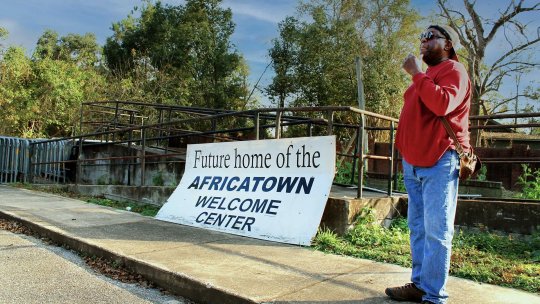
Unlike some of the other descendent families, Darron Patterson was told little of his ancestry (Credit: Zoey Goto)
#Africatown#clotilda#Cudjo#The Last Known Ship of the US Slave Trade#alabama#mobile#Black History Matters
3 notes
·
View notes
Text
I love the brunt of zora neale hurston’s work but she so wrong for lying about the dahomey & lying on cudjoe lewis like dat .
and idk how much of it is hurston& moreso the presumption ppl have made about barracoon being some sort of history… bc it was published at the time in new ebony mag as fictional. and theres this remark on her work (which definitely maps onto barracoon’s prose.. passages about heathens and all)

#‘Yoruba’ HES SPEAKING EFIK. AN ETHNICITY WHO AT THE TIME LIVED THOUSANDS OF MILES AWAY FROM THE DAHOMEY?#she derived much of her conjectures on dahomey str8 from a pro slavery white author & claimed it was cudjoe’s words#yn.#history#africa#blackness#pseudohistory
4 notes
·
View notes
Text
BHM Fact #26
2 notes
·
View notes
Text

The last American slave ship docked illegally in Mobile, Alabama in 1860, carrying about 160 West African captives. Among them was Cudjo Lewis, who recognized how his birth culture might be erased while toiling in this new land.
So when he was freed, he purchased two acres and started a self-sufficient community of survivors of the last slave ship. Known to outsiders as Africatown, Lewis' neighborhood was modeled on his West African home, where extended families lived together, members conversed in their regional languages, and partook in traditions that might otherwise be lost to them in America. Today, Africatown still exists and houses the descendants of the nation's last slave ship community.
Learn more about Cudjo Lewis and his journey to founding an African legacy in America
#old history#history#life lessons#books and reading#cultures#people have always been people#african history#africatown#cudjo lewis#west africa#slavery
0 notes
Text
Escape to Paradise: Stunning Sugarloaf Key Home with Private Dock and Open Water Views
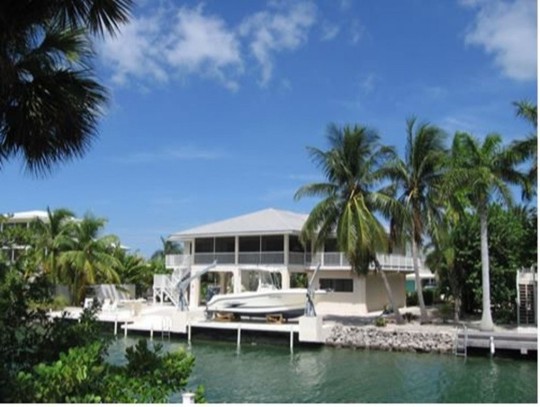
Cudjoe Key Vacation Rentals By Owner
Escape to paradise with this stunning Sugarloaf Key home, located just 20 minutes north of Key West. This beautiful, nicely-maintained home is nestled in a beautifully manicured neighborhood, not far from the Sugarloaf Lodge and Marina, offering you nearby access to boating, fishing, kayaking, and a few local restaurants.
The home features an open floor plan with plenty of seating both inside and outside, making it the perfect home for entertaining or inviting the whole family. The large kitchen boasts plenty of counter space, while the formal dining area and outdoor dining area provide ample room for friends and family to spread out and enjoy fun in the sun.
Just outside the two living room glass doors, you'll find a screened-in porch that's perfectly positioned to capture the south east trade-winds. This airy and spacious porch is perfect for a quiet evening at home or an evening with friends, enjoying the beautiful Sugarloaf Key surroundings.
Outside, on the sprawling property, you'll enjoy beautiful open water views, local vegetation, and world-class sunsets while fishing for your local variety from your own private dock. The dock features a full-size gas grill and fish cleaning station with both power and water, making it the perfect spot for hosting barbecues or enjoying a peaceful day of fishing.
Just a short distance from Key West, South Point Shores offers world-class diving, snorkeling, and boating, historic tours, fabulous shopping, and dining options, all just minutes away. Come and live it up at this beautiful Sugarloaf Key home and experience the best of the Florida Keys!
#House rental in Cudjoe Key#House rental in Cudjoe Key Florida#House for rent in Cudjoe Key Florida#Cudjoe Key Vacation Rentals#Cudjoe Key Vacation Rentals By Owner#find home away#vacation rentals by owner#vacation home rentals#no booking fee vacation rentals
0 notes
Text
Watermelon, like too many other gorgeous things in life, is much too fleeting. 🍉🍉🍉🍉🍉 Barracoon: The Story of the Last "Black Cargo" by Zora Neale Hurston
#quotes#nonfiction#oral history#american history#cudjo lewis#20th century#barracoon by zora neale hurston#zora neale hurston#narrative#african american#african life#watermelon#fleeting pleasures#sic transit gloria mundi
0 notes
Text
Brittany returns the Great Blue Heron White Morph to home territory on Cudjoe Key this afternoon. She rescued the Heron Saturday in a mangrove with a fishing hook stuck through the neck near the trachea. We were able to safely remove the hook and treat the wound. Glad to get this bird rescued and released! Photo credit: Cayman Elston
46 notes
·
View notes
Text

Colonel William Fitch and His Sisters Sarah and Ann Fitch
Artist: John Singleton Copley (American, 1738-1815)
Date: 1800-1801
Medium: Oil on canvas
Collection: National Gallery of Art, Washington, DC, United States
Description
Lieutenant-Colonel William Fitch (died 1795) was a British Army officer, who was killed fighting the Jamaican Maroons during the Second Maroon War.
Fitch was commissioned into the 65th Regiment of Foot on 28 November 1775. He was promoted, in the same regiment, to lieutenant on 2 January 1779 and to captain on 7 December 1779.[3]
Fitch was then promoted to major in the 51st Regiment of Foot on 30 November 1791, and then transferred to the 55th Regiment of Foot on 25 April 1792, before being appointed Lieutenant-Colonel Commandant of the 83rd Regiment of Foot on 28 September 1793.
Fitch embarked for the West Indies in May 1795 and was deployed to Jamaica where he was killed in action later that year during the Second Maroon War.
Newly arrived in Jamaica, Fitch ignored the advice of his experienced Maroon trackers, and led his forces into an ambush by the Maroons of Cudjoe's Town, which resulted in the deaths of Fitch, many members of the white militia, and a number of Accompong warriors.
#portrait#man#women#landscape#horse#soldier#group portrait#family#colonel william fitch#british army officer#full length#urn#foliage#outdoor scene#cloudy skies#wedding gown#black dress#british military uniform#oil on canvas#fine art#oil painting#british culture#john singleton copley#american painter#national gallery of art#19th century painting#artwork#european art
13 notes
·
View notes
Text
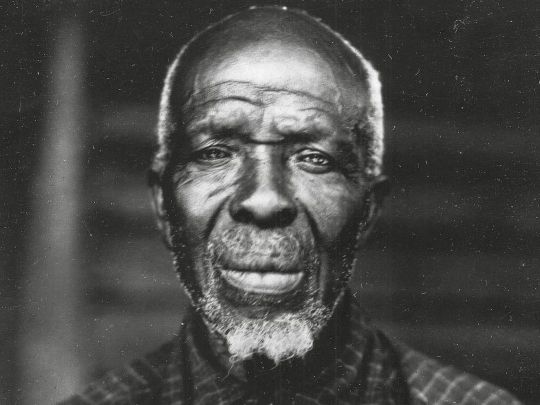
Today We Honor Oluale Kossola, Renamed Cudjo Lewis
Zora Neale Hurston tells the story of Cudjo Lewis, who was born Oluale Kossola in what is now the West African country of Benin in her book “Barracoon: The Story of the Last “Black Cargo.”
A member of the Yoruba people, he was only 19 years old when members of the neighboring Dahomian tribe invaded his village, captured him along with others, and marched them to the coast.
There, he and about 120 others were sold into slavery, after the “Act Prohibiting the Importation of Slaves" took effect in 1808 slavery was abolished, and crammed onto the Clotilda, the “last” slave ship to reach the continental United States.
The Clotilda brought its captives to Alabama in 1860, just a year before the outbreak of the Civil War. Even though slavery was legal at that time in the U.S., the international slave trade was not, and hadn’t been for over 50 years. Along with many European nations, the U.S. had outlawed the practice in 1808.
After being abducted from his home, Lewis was forced onto a ship with strangers. The abductees spent several months together during the treacherous passage to the United States, but were then separated in Alabama to go to different owners.
“We very sorry to be parted from one ’nother,” Lewis told Hurston. “We seventy days cross de water from de Affica soil, and now dey part us from one ’nother.”
“Derefore we cry. Our grief so heavy look lak we cain stand it. I think maybe I die in my sleep when I dream about my mama.”
“We doan know why we be bring ’way from our country to work lak dis,” he told Hurston. “Everybody lookee at us strange. We want to talk wid de udder colored folkses but dey doan know whut we say.”
Confederate General Robert E. Lee surrendered in April 1865, Lewis says that a group of Union soldiers stopped by a boat on which he and other enslaved people were working and told them they were free.
He and a group of 31 other freepeople saved up money to buy land near Mobile, which they called Africatown.
CARTER™️ Magazine
#carter magazine#carter#historyandhiphop365#wherehistoryandhiphopmeet#history#cartermagazine#today in history#staywoke#blackhistory#blackhistorymonth#Instagram
90 notes
·
View notes
Text

Zora Neale Hurston (January 7, 1891 – January 28, 1960) was an author, anthropologist, and filmmaker. She portrayed racial struggles in the early 20th-century American South and published research on Hoodoo. The most popular of her four novels is Their Eyes Were Watching God. She wrote more than 50 short stories, plays, and essays.
She used Eatonville as the setting for many of her stories. It is the site of the “Zora! Festival”, held each year in her honor.
She began her studies at Howard University. She was one of the earliest initiates of Zeta Phi Beta Sorority. She conducted anthropological and ethnographic research while a student at Barnard College and Columbia University. She had an interest in African American and Caribbean folklore, and how these contributed to the community’s identity.
She wrote fiction about contemporary issues in the African American community and became a central figure of the Harlem Renaissance. Her short satires, drawing from the African American experience and racial division, were published in anthologies such as The New Negro and Fire!!. She wrote and published her literary anthropology on African American folklore, Mules and Men, and her first three novels: Jonah’s Gourd Vine; Their Eyes Were Watching God; and Moses, Man of the Mountain. Published during this time was Tell My Horse: Voodoo and Life in Haiti and Jamaica, documenting her research on rituals in Jamaica and Haiti.
Her works concerned both the African American experience and her struggles as an African American woman. Her novels went relatively unrecognized by the literary world for decades. Her manuscript Every Tongue Got to Confess, was published posthumously in 2001 after being discovered in the Smithsonian archives. Her nonfiction book Barracoon: The Story of the Last “Black Cargo”, about the life of Cudjoe Lewis, was published posthumously in 2018. #africanhistory365 #africanexcellence #zetaphibeta
6 notes
·
View notes
Note
I now want to know their thoughts on his backstory (the movie Cujo) and also Henry can adopt him if wanted but Henry does know that Cujo is the same age as him right-

Everyone is really mad at the bats! They bit poor Cujo in the first place!
Well, not everyone...

Remember when I said Jonney was a brat?
Jonney preceeded to make horrible bat related puns! 😒
(He's gonna get a spanking for that later😤 )
And as for poor Henry...

He didn't know Cudjo and he were the same age😅
#welcome home#welcome home puppet#welcome home oc#welcome home fandom#wh fandom#welcome home puppet show#bercia beagle#piper pillar#henry pillar#Jonney darling
8 notes
·
View notes